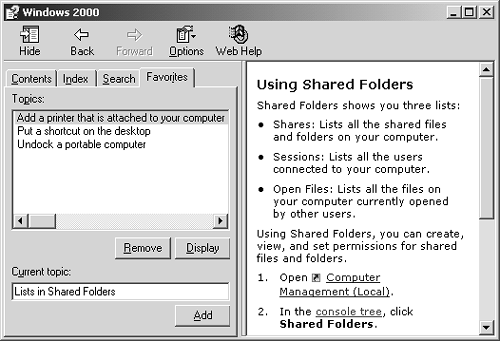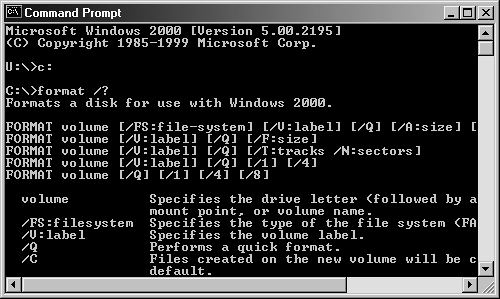Fortunately, there are many sources for help in Windows 2000 Pro—in fact, so many that it's easy to get confused. This brief chapter offers some help with Help.
When Microsoft refers to help, it's generally referring to online help. (As you've noticed, Windows 2000 comes with very little in the way of printed instructions.) The following discussion starts with the simplest and most direct methods of getting online help and proceeds to more complicated ones.
Whenever you're confused or lost in Windows 2000 Pro, press the F1 key, which always stands for Help in Windows and Windows programs. Because the help is context sensitive, the sort of help you'll get depends on where you are and what you're doing. If you're working in a program, the help will be for that program. If you're using some aspect of Windows 2000 Pro, the help will be the operating system's help.
Often you can find useful information if you right-click the dialog box, description, or menu that has you stymied. If a box labeled What's This? pops up, click inside it for more information (see Figure 6-1).
Figure 6-1. If a box labeled What's This? opens when you right-click something in a dialog box, click inside the box for additional information, as shown here by the inset. If you don't get a What's This? box, you may get a menu that provides hints as to the object's function. In some dialog boxes, a question mark appears on the title bar. Click it and then click on the dialog box element that perplexes you; the same kind of identifying box may appear.
In some windows and dialog boxes, you'll see a question mark on the right end of the title bar. Click the question mark then click an item in the dialog box. If instant help is available, a box opens with some explanatory text (Figure 6-1, right).
For help with the Windows program you're using, click Help on the program's menu bar. Depending on the program, this Help menu may contain a command called Help Topics, Contents, or Contents and Index. Select it to open the Help topics specific to that program.
To access the Help system as a whole for Windows 2000 Pro, choose Start→Help (or press F1 at the desktop). The Help Viewer opens, offering an integrated table of contents, an index, and a full-text search feature to find information easily (Figure 6-2).
Figure 6-2. Book icons represent topics and subtopics. Click on one to reveal the contents. The Help Viewer allows you to see the table of contents, index, or search results while you're looking at a Help topic.
The Windows 2000 Help system uses HTML (the Hypertext Markup Language that's used to create Web pages) to format and display information. As a result, many of its pages contain underlined hyperlinks that, when clicked, connect you either to the World Wide Web or, more often, to other topics in the Help system for additional information.
To find a topic in the Help Viewer, click one of the tabs.
Contents. The Contents tab displays a table of contents organized by subject. You can browse by clicking the book icons to reveal topics and subtopics. Click a topic to display the contents (Figure 6-2).
Index. The Index tab displays the Help system's contents in alphabetical order. If you know a word that describes the subject you're looking for, type it in the field at the top of the tab. Double-click an index entry to display the topic. (Topics are frequently indexed under more than one entry.)
Search. To find every instance of a word or phrase, type it on the Search tab and then click List Topics. Be as specific as possible. For example, if you're looking for information on virtual private networking, you get better results by searching for all three words (or VPN) than if you search for networking alone. Both searches return many results, but the networking search results will include dozens of entries that have nothing to do with VPN.
Favorites. Once you find the information you need, you can bookmark the topic so you can find it again faster the next time. This tip is especially useful for procedures that you use regularly, but not so often that you memorize the steps.
To bookmark a help page that's currently on the screen, click the Favorites tab and then the Add button (Figure 6-3). The Help viewer adds the title to the topics list; you can return to it later by double-clicking its name in the list.
If you're connected to the Internet, you can click the Web Help button on the Help Viewer's button bar for Web-based help and technical support, as shown in Figure 6-4.
To print a particular Help topic, right-click the topic window and choose Print from the shortcut menu. To print just part of a topic, use the mouse to highlight the text you want to print. Right-click in the highlighted portion, and then choose Print from the shortcut menu.
To print all the topics in a section, select the topic on the Contents tab. On the Help toolbar, click Options→Print. In the Print Topics dialog box, select Print the Selected Heading and All Subtopics, and then click OK.
To copy information in the Help viewer to another document, follow these steps:
In the topic pane of the Help viewer, right-click inside the topic and then Select All from the shortcut menu.
All of the help text is now highlighted.
Right-click again inside the topic window and select Copy.
Windows 2000 copies the selected material to the invisible Clipboard.
Open the document to which you want to copy the topic, such as a word processing document or email message. Click where you want the topic to appear. Finally, right-click where you want the text to appear and choose Paste from the shortcut menu.
To get the latest documentation for Windows 2000 Pro, go to the Windows 2000 Home Page at http://www.microsoft.com/windows2000.
If you are an administrator (logged on with administrative privileges; see Section 17.3), you can go to Windows Update (on your Start menu and at http://windowsupdate.microsoft.com ) to download and install the latest drivers, patches, and new help files.
To get help for an MS-DOS command, click Start→Programs→Accessories→Command Prompt. In the command prompt window, type the name of the command followed by /? (a slash and a question mark), as shown in Figure 6-5.
Figure 6-5. For information on the Format command, you'd type in format /?, as shown here. You can use the scroll bars on the window to see all the Help information.
To see a list of all MS-DOS commands that you can use from a Windows 2000 command prompt, along with short description of what they do, simply type help at a command prompt, and then use the scroll bar to read the (long) list of commands.





